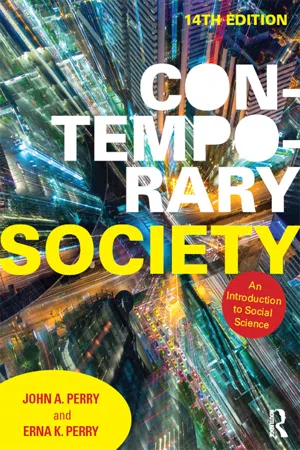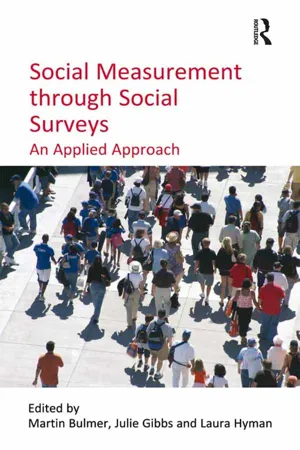Social Sciences
Significance Of Social Class
The significance of social class refers to the impact of one's position within a societal hierarchy on various aspects of life, such as access to resources, opportunities, and power. It influences individuals' lifestyles, education, health, and economic status, shaping their experiences and opportunities. Understanding social class is crucial for addressing inequality and social justice issues.
Written by Perlego with AI-assistance
Related key terms
7 Key excerpts on "Significance Of Social Class"
- eBook - ePub
- Eric J. Arnould, Craig J Thompson(Authors)
- 2018(Publication Date)
- SAGE Publications Ltd(Publisher)
7 Social Class Paul Henry University of Sydney Business School Marylouise Caldwell University of Sydney Business SchoolChapter Overview
- Social class influences the distribution of socio-economic opportunities, and quality of life.
- Socialization in your social class group shapes your sense of self, where you feel or ‘at home’ or ‘out of place’ and how you think about the world.
- A class group exhibits distinctive consumer tastes and consumption patterns.
- These patterns of taste preferences reflect different combinations of economic, social, and cultural resources.
- Class-based preferences are more emotional and habituated and less rational and calculative.
- Social class distinctions are expressed as matters of taste and reproduce the symbolic boundaries between more and less well resourced groups.
Introduction
In an age of great change that features increased geographic mobility, technological advances in production and consumption, faster fashion cycles, disruption to old industry and occupational types, more diverse lifestyle options, and breakdown of old left–right political allegiances, social roles, categories, and hierarchies can be disrupted, fragmented, and re-organized. For example, the forces of globalization, industrial automation, and corporate downsizing have radically transformed the nature of working-class and middle-class identities. However, these structural influences of social class remain firmly in place and continue to position people into hierarchies of distinctive class groups. Yet, we do acknowledge that the turbulence of change often disguises the underlying role of class in modern societies. In this chapter, we seek to illuminate the continuing relevance of social class.How Class Sets People Apart
Systemic economic inequality sits at the heart of social class. Casual observation in daily life where we see people who are obviously either better off or worse off than ourselves, provides evidence of economic disparity. If you look at any major city you will find pockets of (dis)advantage where statistics reveal layer upon layer of inequality that ranges from family income, education, occupation, unemployment, and interestingly a large range of inequitable health outcomes. In particular, health statistics point to very different patterns of physical activity and dietary consumptions. They also point to different levels and types of stress experiences and ultimately differences in quality of life between advantaged and disadvantaged groups. Inequality results in different lived experiences. News stories detailing an increasing gap between incomes of the rich and poor appear regularly in mass media. The disparity in life chances is usually attributed to income and wealth – and clearly this is a part of it. - eBook - ePub
Contemporary Society
An Introduction to Social Science
- John A Perry, Erna K Perry(Authors)
- 2016(Publication Date)
- Routledge(Publisher)
In contemporary industrial societies, power and wealth are closely interconnected in both capitalist and socialist economies. In capitalist countries, the wealthy are more likely to come to power, and in socialist nations the powerful are likely to become wealthy. However, the stratification systems of both kinds of economies are strikingly similar. Societies that have a long tradition of feudal-like stratification, although they have become open in the industrial era, retain strong class boundaries.Determining Social Class: Occupational Prestige and Socioeconomic StatusSocial scientists disagree not only about the number of social classes in existence but also about the standards that determine who belongs in which class. The categories used by researchers to pigeonhole people into social classes are arbitrary and artificial.Historically, a number of approaches have been used to determine social class. Today, however, most researchers use one of two. In the occupational prestige approach, researchers ask people which occupations and sources of income are the most prestigious. This approach depends on a large sample, usually on a national scale. The occupational prestige approach has proved to be the best index of social class in the United States because of its practicality. Occupation determines the amount of money that is earned, which in turn determines, in many cases, the amount of power wielded and the prestige held. But money alone does not determine social class. Some occupations are rated very high even though the monetary rewards are relatively low, and vice versa.A more common methodological device is based on an index that combines a number of dimensions relevant to stratification. One such index measures socioeconomic status (SES). Such an index shows at a glance the position of individuals in the social and economic pecking order. The development of such an index is possible despite instances of status inconsistency because of the related nature of the dimensions of stratification in American society. - eBook - ePub
- Ken Browne(Author)
- 2019(Publication Date)
- Polity(Publisher)
✘ It underestimates the power of the ruling class with which Marx was concerned. In most cases, those with the most power in society are those belonging to the highest social classes and status groups, and the most successful parties tend to be those which least threaten the interests of the ruling class.Defining class by occupationOccupation or socio-economic group is the most common indicator of social class used by governments, by advertising agencies when doing market research, and by sociologists when doing surveys. This is because occupation is:- an easy piece of information to obtain from people
- generally a good guide to people’s skills, qualifications, their income, their lifestyle, their health and other life chances, and other important aspects of their lives
- a major factor influencing people’s power and status in society, and most people judge the social standing of themselves and others by the jobs they do.
There is a wide range of occupational scales in use, but two of the bestknown and most widely used ways of grading occupations into socio-economic classes are the National Statistics Socio-Economic Classification (NS-SEC), shown in table 6.1 , and the Institute of Practitioners in Advertising (IPA) Scale (table 6.2 ). The NS-SEC is used for all official statistics and surveys, and the IPA Scale is widely used in market research and many surveys, including opinion polls. Tables 6.1 and 6.2 include references to what percentage of the population over 16 belong to each of these classes, and what these classes roughly refer to in the everyday language used by sociologists: the middle-class and working-class categories found in this book.- Middle-class occupations are generally non-manual, with people working primarily in offices, doing mainly mental rather than physical work. The term white-collar workersis sometimes used to refer to lower-middle-class clerical and sales occupations.White-collar workers
- eBook - ePub
Social Class and Classism in the Helping Professions
Research, Theory, and Practice
- William Ming Liu(Author)
- 2010(Publication Date)
- SAGE Publications, Inc(Publisher)
For those who do want to integrate social class into research or assessment, the first step is to conceptualize the relationship between social class and the other variables of interest. The researcher should consult and review the available literature and determine what aspects of social class (e.g., income, education, occupation, wealth) are relevant and may play a role in the results. Certainly all of these aspects of social class may have some role, but to collect necessary and meaningful data is more important than collecting any and all data on social class. If possible, the researcher should consider theoretical guidance to help conceptualize the role of social class. The next step would be to find an available measure, and if there is none, to ask specific and direct questions about the social class construct of interest. It is important to be thoughtful about these questions rather than just to ask the obvious and surface-level questions. Asking about educational level and attainment only is a surface-level question, but asking about educational history and a timeline would be asking the less-obvious questions.Besides analyzing the data, the final step would be to contextualize the social class-related data. Contextualizing the data means the researcher should provide social class data about the population being studied (e.g., income, education, occupation) and the locale in which the study is taking place (e.g., the annual income of people in that community). Contextualizing the study also means providing social class data about participants in other relevant studies. Is this current study’s population higher, lower, or within a reasonable standard deviation in comparison to other study participants? I offer these considerations not as an exhaustive list but to provide a place for researchers and other helping professionals to understand how social class may be better used and integrated into research. - eBook - ePub
Social Measurement through Social Surveys
An Applied Approach
- Julie Gibbs, Martin Bulmer(Authors)
- 2016(Publication Date)
- Routledge(Publisher)
This type of validation is easier to undertake because, and only because, in addition to the major general-purpose social surveys, even surveys designed to collect quite specific information include the sorts of items required to create a social class variable. To recap, the argument is that employment relations and conditions are central to delineating the structure of socio-economic positions in modern societies. That is, the life chances of individuals and families depend mainly on their position in the division of labour and on the material and symbolic advantages that derive from it. Thus, for example, health inequalities are differences between class categories in respect of morbidity and mortality. The study of these inequalities makes visible the social forces acting to produce health outcomes. Moreover, it informs public policy by illuminating not merely the problem, but the appropriate levers for effecting change. Research using both NS-SEC and ESeC has clearly shown that class has plausible, instructive and informative relationships with key outcomes of interest in areas as diverse as income, poverty and deprivation, unemployment risks, and health and educational inequalities (Rose and Pevalin, 2003; Rose and Harrison, 2009).Class Analysis and Large-scale Data Sets: Towards a Sociological Alliance?
This chapter has offered a number of arguments designed to show the importance of social class as a variable central to empirical research in the social sciences. It has shown that from an academic perspective, class should be theorized and measured in ways that allow it not just to describe systematic differences across and between populations, but to assist in the explanation of those differences. In order to do this kind of macro-sociology, it is crucial that there are frequent large-scale surveys that collect relevant data, and that this is recorded and coded with sufficient precision and reliability to allow analysts to produce descriptive and inferential statistics that are scientifically credible. It is also important that they are able to repeat this work with comparable data in order to validate and maintain their measures both over time and across space. It is no surprise that one of the central protagonists in class analysis is also one of the most influential lobbyists for the quantitative analysis of large-scale data sets in sociology (Goldthorpe, 2000). - eBook - ePub
- Anthony Giddens, Philip W. Sutton(Authors)
- 2021(Publication Date)
- Polity(Publisher)
In analysing people’s class location, sociologists have conventionally relied on indicators such as market position, occupation and relationship to the means of production. However, more recently it has been argued that we should evaluate class location not only, or even mainly, in terms of economics and employment but also in relation to cultural factors such as lifestyle and consumption patterns. Ulrich Beck (Beck and Beck-Gernsheim 2001: 203) argued that the concept of social class has lost its purchase in today’s complex societies and has become a ‘zombie category’ in sociology – essentially lifeless in society at large, but still stalking the discipline’s practitioners. According to the ‘cultural turn’ in stratification research, contemporary societies are now marked by the greater significance of ‘symbols’ and markers of consumption, which play a crucial role in daily life. Individual identities are structured to a larger extent around lifestyle choices – such as how we dress, what we eat, how we care for our bodies and where we relax – and less around conventional class indicators such as the type of work we do.The French sociologist Pierre Bourdieu argued that lifestyle choices are an important indicator of class. He saw that economic capital – material goods such as property, wealth and income – was important, but he argued that it could provide only a partial understanding of social class as it is lived (Crompton 2008). He identifies four forms of ‘capital’ that characterize class position, of which economic capital is only one: the others are cultural, social and symbolic capital (Bourdieu 1986).See chapter 16 , ‘Education’, for an extended discussion of Bourdieu’s theoretical scheme.Bourdieu argues that people increasingly distinguish themselves from others not on economic criteria but on the basis of cultural capital - eBook - ePub
- Paul Higgs, Graham Scambler(Authors)
- 2005(Publication Date)
- Routledge(Publisher)
Our object in this chapter is to proffer neither another review of current empiricist research on class and health inequalities, nor another critique of assorted neo-positivisms, both of which are plentiful, but rather to reflect on the ramifications of ongoing pivotal sociological debates about class in the mainstream of the discipline for the future consideration of health inequalities. One of our reasons for doing so is to restore the political nature of class to the debate about inequalities. This implicit political debate has already been commented upon by Klein (1991) and underlines the need to understand these questions as connected to wider concerns. Bury (1997) points out:There is little point, for example, in collecting detailed evidence about physical characteristics of individuals, say the colour of their eyes or hair, unless it has some relevance to life chances, including health. Evidence about the attributes of people only matters to epidemiologists and sociologists at least, if they have social significance. It is, in the present context, the outcome of influences of social position on health status that matters, and invoking the term ‘inequalities’ frequently rests on the assumption that modern societies are characterised by social hierarchies…which structure and to some extent determine people’s lives.(Bury 1997:48–9)In the opening section we focus on arguments that researchers of health inequalities have been overly dependent on under-theorized or outmoded notions or measures of class; this charge is premised on a lack of sophistication. In the second section we look at the increasingly popular contention that, however conceptualized or measured, class no longer has the explanatory power it had during the heyday of industrial capitalism; this charge is sometimes premised on a putative transition to post-industrial capitalism or, more radically, to a new era of postmodernity. In the third section we offer some general comments on the continuing significance of class. And finally, arising from these comments, we suggest some possible lines of investigation for the future.A LACK OF SOPHISTICATION?
The charge of insufficient sophistication typically takes one of two forms. These are conveniently encapsulated in the distinction between ‘class theory’ and ‘class analysis’.Class theory
According to Pakulski and Waters (1996:10), ‘class theory’, of which neo-Marxist versions are the most prominent, embraces the four propositions of ‘economism’ (i.e. class is a fundamentally economic phenomenon); ‘groupness’ (i.e. classes are real features of social structure rather than mere statistical aggregates or taxonomic categories); ‘behavioural and cultural linkage’ (i.e. class is causally linked to consciousness and identity); and ‘transformational capacity’ (i.e. classes are potential actors in economic and political arenas). Similar criteria were raised by Mann (1974) over two decades previously in his attempt to delineate the problems of totalizing class in a combined ontological and political way.
Learn about this page
Index pages curate the most relevant extracts from our library of academic textbooks. They’ve been created using an in-house natural language model (NLM), each adding context and meaning to key research topics.






